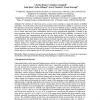Free Online Productivity Tools
i2Speak
i2Symbol
i2OCR
iTex2Img
iWeb2Print
iWeb2Shot
i2Type
iPdf2Split
iPdf2Merge
i2Bopomofo
i2Arabic
i2Style
i2Image
i2PDF
iLatex2Rtf
Sci2ools
108
Voted
CORR
2004
Springer
2004
Springer
Swarming around Shellfish Larvae
: The collection of wild larvae seed as a source of raw material is a major sub industry of shellfish aquaculture. To predict when, where and in what quantities wild seed will be available, it is necessary to track the appearance and growth of planktonic larvae. One of the most difficult groups to identify, particularly at the species level are the Bivalvia. This difficulty arises from the fact that fundamentally all bivalve larvae have a similar shape and colour. Identification based on gross morphological appearance is limited by the time-consuming nature of the microscopic examination and by the limited availability of expertise in this field. Molecular and immunological methods are also being studied. We describe the application of computational pattern recognition methods to the automated identification and size analysis of scallop larvae. For identification, the shape features used are binary invariant moments; that is, the features are invariant to shift (position within the ima...
| Added | 17 Dec 2010 |
| Updated | 17 Dec 2010 |
| Type | Journal |
| Year | 2004 |
| Where | CORR |
| Authors | Vitorino Ramos, Jonathan Campbell, John Slater, John Gillespie, Ivan F. Bendezu, Fionn Murtagh |
Comments (0)

